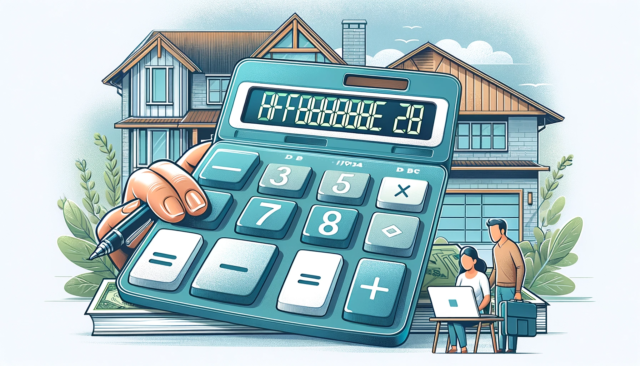Importance of mortgage pre-approval in the home buying process
When embarking on the exciting journey of buying a new home, one crucial step that often gets overlooked is getting mortgage pre-approval. This essential process is often misunderstood or underestimated, but it plays a vital role in ensuring a smooth and successful home buying experience.
Mortgage pre-approval is the initial step that potential homebuyers should take before they start shopping for their dream home. It involves a thorough assessment of their financial situation by a lender or a financial institution to determine the maximum loan amount they can borrow and the interest rate they can secure. This pre-approval not only provides buyers with a clear understanding of their purchasing power but also gives them an edge in a competitive real estate market.
For any serious homebuyer, mortgage pre-approval is of utmost importance. It offers numerous benefits that can save both time and effort in the long run. By obtaining pre-approval, buyers gain a clear picture of their financial capabilities, allowing them to set a realistic budget and focus their search on properties within their means. This prevents the disappointment of falling in love with a home only to discover it is beyond their financial reach.
Additionally, having a pre-approval letter in hand demonstrates to sellers that you are a serious buyer who is ready and able to make a purchase. In a competitive market, where multiple buyers may be vying for the same property, pre-approval can give you a significant advantage. It shows sellers that you are a qualified buyer and can expedite the negotiation process.
It’s important to note that mortgage pre-approval differs from pre-qualification. Pre-qualification is a basic assessment that provides an estimate of how much you may be able to borrow based on the information you provide. On the other hand, pre-approval involves a more comprehensive evaluation, including a review of your credit history, income verification, and documentation of your assets. Pre-approval gives you a more accurate understanding of what you can afford and provides a stronger commitment from the lender.
In the upcoming sections, we will dive deeper into the mortgage pre-approval process, exploring the necessary steps to master it successfully. We will also address common questions and provide valuable tips to ensure a seamless journey towards homeownership. So, let’s get started on this exciting path to finding your dream home!
Understanding Mortgage Pre-Approval
When embarking on the exciting journey of purchasing a new home, it’s essential to understand the ins and outs of the mortgage pre-approval process. Securing a mortgage pre-approval is a vital step that can streamline your home buying journey and provide you with a clear understanding of your financial capabilities. Let’s delve into what mortgage pre-approval entails, why it holds immense significance, and how it differs from pre-qualification.
What is mortgage pre-approval?
Mortgage pre-approval is a preliminary evaluation conducted by a lender to determine the maximum amount of money they are willing to lend you for your home purchase. This evaluation is based on a comprehensive assessment of your financial history, creditworthiness, and overall financial health. It involves a thorough review of your income, assets, debts, and credit report.
Receiving a mortgage pre-approval is an encouraging indication that you have met the initial criteria set by the lender, making you a serious and qualified buyer. While it doesn’t guarantee a final mortgage offer, it provides you with a solid foundation and invaluable knowledge as you navigate the home buying process.
Why is it important?
Mortgage pre-approval holds immense importance for several reasons. Firstly, it helps you determine a realistic budget for your home purchase. Armed with this knowledge, you can confidently search for homes within your price range, ensuring that you don’t waste time or energy on properties that are beyond your financial reach. It also prevents the disappointment of falling in love with a home only to discover later that it’s outside your budget.
Secondly, mortgage pre-approval enhances your credibility as a buyer. Sellers are often more inclined to consider offers from pre-approved buyers as they have already demonstrated their financial capability. In a competitive housing market, having a pre-approval letter can give you an edge over other potential buyers.
Lastly, mortgage pre-approval expedites the overall home buying process. As you have already completed a significant portion of the paperwork and financial evaluation, the final mortgage approval process tends to be smoother and quicker. This can save you valuable time and enable you to seize opportunities swiftly when you find the perfect home.
Difference between pre-approval and pre-qualification
While the terms “pre-approval” and “pre-qualification” are often used interchangeably, they have distinct differences. Pre-qualification is a simpler, less comprehensive evaluation that provides a rough estimate of the mortgage amount you may qualify for. It typically involves a basic assessment of your financial information, such as your income and debt levels. Pre-qualification is a useful initial step to gauge your eligibility, but it lacks the thoroughness and reliability of pre-approval.
On the other hand, mortgage pre-approval involves a detailed analysis of your financial health, including an in-depth review of your credit report and documentation of your income, assets, and debts. It carries more weight and provides a more accurate picture of your borrowing capacity. When you have a pre-approval, you can confidently approach sellers, knowing that you are a serious buyer who has undergone a rigorous evaluation.
Understanding the nuances between pre-approval and pre-qualification is crucial to ensure you have a clear grasp of your financial standing and can make informed decisions throughout the home buying process.
Now that we have a solid understanding of mortgage pre-approval, let’s delve into the steps you can take to master this process and streamline your home buying journey. But before we do, let’s address some common questions that often arise when it comes to mortgage pre-approval.
Steps to Master the Mortgage Pre-Approval Process
Embarking on the journey of buying a home can be simultaneously exciting and overwhelming. One crucial step that can help streamline this process is obtaining a mortgage pre-approval. By securing pre-approval, prospective homebuyers gain a distinct advantage in the competitive real estate market.
Now, let’s delve into the essential steps to master the mortgage pre-approval process.
Step 1: Gather Financial Documents
Before diving into the pre-approval process, it is crucial to gather all the necessary financial documents. These documents typically include recent pay stubs, bank statements, tax returns, and any other relevant financial records. Lenders use these documents to assess your financial stability and determine your eligibility for a mortgage.
Pro tip: Stay organized by creating a file or folder to keep all your financial documents in one place. This way, you can easily access them when needed throughout the pre-approval process.
Step 2: Calculate Your Budget
Determining your budget is a pivotal step in the pre-approval process. It allows you to understand how much you can comfortably afford to spend on a home. Take into account factors such as your income, expenses, and debt-to-income ratio. Online home affordability calculators can be useful tools to get a ballpark estimate of your budget.
Pro tip: Keep in mind that just because you may be pre-approved for a certain amount doesn’t mean you have to spend the maximum. Consider your lifestyle and long-term financial goals when setting your budget.
Step 3: Find a Lender
Finding the right lender is essential for a smooth pre-approval process. Take the time to research and compare different lenders, considering factors such as interest rates, fees, and customer reviews. Look for lenders who specialize in home loan financing and have a reputation for excellent customer service.
Pro tip: Don’t be afraid to ask questions and seek clarification during your conversations with potential lenders. A good lender will be patient, knowledgeable, and able to guide you through the pre-approval process.
Step 4: Submit Your Application
Once you’ve chosen a lender, it’s time to submit your pre-approval application. The lender will require information about your employment history, income, assets, and debts. This thorough assessment allows the lender to evaluate your financial situation and determine the amount you may be eligible to borrow.
Pro tip: Double-check your application for accuracy and completeness before submitting it. Any missing or incorrect information could delay the pre-approval process.
Step 5: Wait for the Pre-Approval Decision
After submitting your application, there is typically a waiting period while the lender reviews your information. The length of this period can vary, but it is generally a good idea to expect a response within a few business days. During this time, the lender will evaluate your creditworthiness and assess the risk associated with offering you a mortgage.
Pro tip: Patience is key during this stage. While waiting, avoid making any major financial decisions or changes that could impact your pre-approval decision.
Step 6: Utilize Your Pre-Approval Letter
Once you receive your pre-approval decision, it’s time to celebrate! You can now utilize your pre-approval letter to your advantage. This letter serves as proof that you are a qualified buyer and can be presented to real estate agents and sellers to demonstrate your serious intent to purchase a home. The pre-approval letter gives you a competitive edge in a competitive market, as sellers often prioritize offers from pre-approved buyers.
Pro tip: Remember that a pre-approval is not a guarantee of a mortgage. Your pre-approval is typically valid for a limited time, so it’s important to act promptly and start your home search.
By following these steps and mastering the mortgage pre-approval process, you’ll be well on your way to securing the home of your dreams. Remember to maintain good credit, pay off debts, save for a down payment, and avoid major financial changes to ensure a smooth pre-approval experience.
Stay tuned for our upcoming article where we’ll answer common questions about mortgage pre-approval and provide additional tips to help you navigate the home buying journey.
Common Questions about Mortgage Pre-Approval
As you embark on your home buying journey, it’s natural to have questions about the mortgage pre-approval process. Understanding the details can help you feel more confident and informed as you navigate this crucial step. So, let’s address some of the most common questions that homebuyers have about mortgage pre-approval.
How long does the pre-approval process take?
The duration of the mortgage pre-approval process can vary depending on several factors. On average, it typically takes around 1 to 3 business days to receive a pre-approval decision. However, it’s important to note that this timeline can be influenced by various elements, such as the lender’s workload, the complexity of your financial situation, and the promptness of your document submission.
To expedite the process, it’s recommended that you gather all the necessary financial documents beforehand, as well as have a clear understanding of your budget. By being prepared, you can help streamline the pre-approval process and potentially receive a decision sooner.
Does pre-approval guarantee a mortgage?
While mortgage pre-approval is a significant step towards securing a home loan, it does not guarantee final approval. Pre-approval is based on the information provided to the lender at the time of application, including your income, credit history, and other financial factors. However, the lender will conduct a more thorough evaluation of your financial documents, employment verification, and property appraisal before granting the final mortgage.
It’s crucial to remember that pre-approval is not a binding commitment from the lender. It serves as an initial assessment of your financial readiness and helps you understand the price range of homes you can consider. Once you find a home and proceed with the purchase, the lender will review the property and complete the underwriting process to finalize the mortgage.
Can I still shop around after getting pre-approved?
Absolutely! In fact, it’s highly recommended that you continue to shop around and explore different options even after receiving a pre-approval. Pre-approval provides you with a clear understanding of your budget and strengthens your position as a serious buyer. Armed with this information, you can confidently search for homes that fall within your approved price range.
Additionally, shopping around allows you to compare mortgage rates, terms, and fees from different lenders. This ensures that you secure the most favorable home loan financing options available. By doing your due diligence and exploring various lenders, you can potentially save thousands of dollars over the life of your mortgage.
In conclusion, having a solid grasp of the common questions surrounding mortgage pre-approval can help you navigate the process with confidence. Remember that while pre-approval is a vital step, it’s not a guarantee of the final mortgage. Stay proactive, continue to explore your options, and make informed decisions based on your financial circumstances and goals. Happy home hunting!
*[PMI]: Private Mortgage Insurance
Tips for a Smooth Mortgage Pre-Approval Process
To ensure a seamless mortgage pre-approval process, there are several important tips to keep in mind. By following these guidelines, you can increase your chances of obtaining a favorable pre-approval decision and streamline your home buying journey.
Maintain Good Credit
One of the most critical factors that lenders consider when evaluating a mortgage pre-approval application is your creditworthiness. It’s essential to maintain good credit by consistently paying your bills on time, minimizing your debt, and avoiding any negative marks on your credit report. A high credit score demonstrates to lenders that you are a responsible borrower and can increase your chances of securing a favorable mortgage.
Pay Off Debts
In addition to maintaining good credit, it’s crucial to pay off debts as much as possible before applying for a mortgage pre-approval. Lenders take into account your debt-to-income ratio, which compares your monthly debt payments to your monthly income. By reducing your outstanding debts, you can lower your debt-to-income ratio and show lenders that you have the financial capacity to handle a mortgage.
Save for a Down Payment
Saving for a down payment is a key component of the home buying process. A larger down payment not only reduces the amount you need to finance but also demonstrates to lenders that you have the financial discipline and ability to save. By saving for a substantial down payment, you can potentially qualify for more favorable loan terms and avoid the need for private mortgage insurance (PMI), which can add to your monthly mortgage expenses.
Avoid Major Financial Changes
During the mortgage pre-approval process, it’s crucial to avoid major financial changes that could impact your financial stability. Lenders prefer stability and consistency when evaluating borrowers. Major financial changes such as switching jobs, taking on new debts, or making significant purchases can raise concerns for lenders and potentially affect your pre-approval decision. It’s best to maintain a steady financial situation until you’ve secured your mortgage.
By following these tips, you can navigate the mortgage pre-approval process with confidence and increase your chances of obtaining a favorable pre-approval decision. Remember to prioritize maintaining good credit, paying off debts, saving for a down payment, and avoiding major financial changes. These steps will not only streamline your journey to homeownership but also position you as a qualified and attractive borrower in the eyes of lenders.
For additional resources and tools to help you with the home buying process, consider exploring Dwelly’s guides on home affordability calculators, down payment assistance programs, homebuyer tax credits, and home loan financing. These valuable resources can provide you with further insights and assistance as you embark on your journey to homeownership.
Conclusion
Mastering the mortgage pre-approval process is an essential step in streamlining your home buying journey. By understanding what mortgage pre-approval is and why it is important, you can confidently navigate the path to homeownership.
Throughout this article, we have explored the difference between pre-approval and pre-qualification, the steps involved in the pre-approval process, and common questions that may arise. We have also provided tips to ensure a smooth pre-approval experience.
Remember, mortgage pre-approval not only gives you a clear understanding of your budget and affordability but also strengthens your position as a serious buyer in the eyes of sellers. With a pre-approval letter in hand, you can confidently make offers on your dream home, knowing that you have the financial backing to support your purchase.
To start the pre-approval process, gather all the necessary financial documents, calculate your budget, and find a reputable lender. Once you’ve submitted your application, be patient as you wait for the pre-approval decision. In the meantime, utilize your pre-approval letter to your advantage by showcasing your financial readiness to real estate agents and sellers.
It’s important to note that while pre-approval is a significant step, it doesn’t guarantee a mortgage. Lenders will still conduct a thorough evaluation of your financial situation before finalizing the loan. Therefore, it’s crucial to maintain good credit, pay off debts, save for a down payment, and avoid any major financial changes during the pre-approval process to maximize your chances of securing a mortgage.
If you have any lingering questions or concerns, don’t hesitate to reach out to a mortgage professional who can guide you through the process. They can provide personalized advice based on your unique situation.
In conclusion, mastering the mortgage pre-approval process sets the stage for a successful home buying journey. By taking the time to gather your financial documents, calculate your budget, and find a lender, you can confidently navigate the pre-approval process and position yourself as a competitive buyer. With a pre-approval letter in hand, you’re one step closer to unlocking the doors to your dream home.
If you’re interested in learning more about home affordability calculators, down payment assistance programs, homebuyer tax credits, home loan financing, or private mortgage insurance (PMI), be sure to check out our comprehensive guides on each topic.



